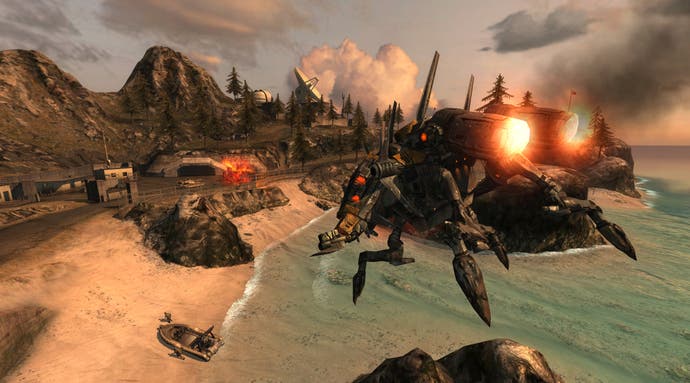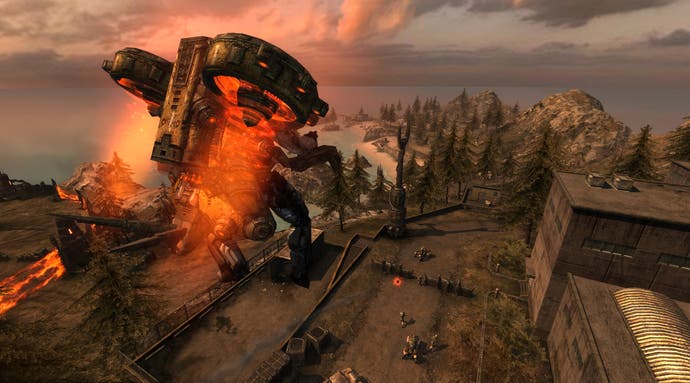Enemy Territory: Quake Wars
Paul Wedgwood on tick-rates, levels, bots and the future.
When it comes to multiplayer FPS games, large-scale testing is proof - and where better to test the first proper from-the-ground-up teamplay multiplayer Quake FPS than QuakeCon, id Software's annual shindig in Dallas? That's certainly the view of id's cohorts Splash Damage, who not only brought the PC and 360 builds to the Con's vendor area, but also distributed Beta 2 among attendees on day one, ran a clan tournament on a range of new maps, and put on a series of advanced tactics seminars for budding fans. With all that in mind, we caught up with creative director Paul Wedgwood to talk about the new levels, the bots, the future - and John Carmack's potentially needling comments the night before when a keynote Q&A brought up the subject of animation and gameplay synchronicity...
There's a ton going in Quake Wars. You have to realise that there are 24 players, all of them can have deployables that can be firing, and be in vehicles, and then of course we're tracking experience points, objectives and their status, and have physics attached to almost everything. Even just overcoming the network challenges took some significant advances.
In terms of the server and the client, the problem comes when you try to process all of that data 60 or 90 times a second or have it uncapped, because the gameplay experience when a server a or client shifts constantly from 30 to 90 to 60 ends up much worse than having a locked-out 30fps. We started by reducing everything to 30Hz to see how that would work, but players felt the gameplay wasn't smooth enough.
So Timothy over at id Software worked on a solution that unhooked rendering from game sampling, and we have a much smoother experience now. We have unlocked frame-rates and people who were previously around 30fps are now getting 60fps because we've made a ton of performance improvements. That said, the animation problem can't be solved. It can't be. As the game stands right now, it's just one of the insurmountable hurdles.

Yeah, but ultimately the most important thing is that what you shoot is what you hit, and that's more important than having really smooth animation. We're faced with the choice of giving you a smooth gameplay experience with really good hit-registration and really good player-prediction and really good networking, or something that is heavily interpolated and gives you the impression that everything's running really smoothly, except that vehicle isn't really where you think it is and that animation isn't really playing and half of the game is client-side prediction.
Yeah exactly, and gamers are more obsessed with knowing that what they're shooting is actually where you say it is, and that's what we've achieved with things like the anti-lag code. Say you're on 150ms ping and I'm on a 33ms ping - if someone's head is under your sniper rifle when you shoot them you actually get that hit, that hit is registered appropriately, and that levels the playing field without imposing any penalty on anybody else. The low-ping guy doesn't suffer for your lag.

I really don't think it affects anybody at all. I think we've definitely made the right choice for the gameplay. Of course everything in game development is a series of compromises, like whether to have destructible geometry. You could have destructible geometry, but not have great vehicle physics - you have to decide whether these things are purely immersive or whether they significantly benefit gameplay, and if they're purely immersive then you end up thinking there's not much point simulating reality in this situation and emulate reality instead.
If it's immersion plus gameplay or a pure gameplay mechanism like constructing a bridge with a pair of pliers, we realise that that damages immersion for some people, but it's the best mechanic for making the game competitive and fun, and so we will sacrifice immersion in the pursuit of better gameplay, because gameplay has better longevity. The game isn't going to look good three years from now, but the game should be as fun or more fun.
Sure. In Quake 2 the retaliation against Stroggos is led because the humans have learnt how to use slipgate technology and the first map, Area 22, is really the telling of that battle. It's an arid-themed map. It has the Strogg attacking, initially to take the power out of a big EMP that the GDF have erected. When they take it down, the Strogg are able to deploy a mining laser from orbit. This blows the doors off a bunker and gets them into the final objective room which, just like every other map, is entirely unique. You've got the big slipgate with all of the lab equipment around it. You'd never confuse it with any other. Each map really works as a mnemonic.








